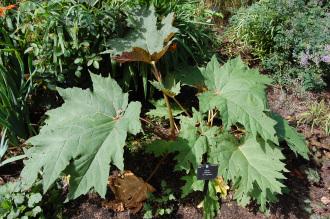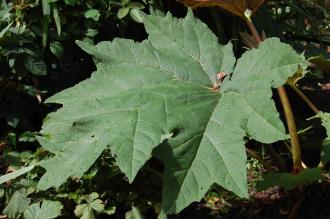
Rheum palmatum var. tanguticum (15/08/15, Kew Gardens, London)
Position: Full sun to partial shade
Flowering period: Late spring to mid summer
Soil: Moist, well drained to boggy
Eventual Height: 90cm (2m with flower spike)
Eventual Spread: 1.8m
Hardiness: 5b, 6a, 6b, 7a, 7b, 8a, 8b, 9a, 9b
Family: Polygonaceae
Rheum palmatum var. tanguticum is a deciduous herbaceous perennial with a clump forming habit. Its mid to dark green leaves emerge dark red, are orbicular or broadly ovate with pointed lobes and undulate margin, up to 60cm long and 60cm across. Its dark pink flowers appear on long stalks in the form of panicles and are wind pollinated. Its roots are rhizomatous.
Rheum palmatum var. tanguticum, commonly known as Chinese Rhubarb and Da Huang, is native to eastern Asia including northwest China. In its native habitat it grows by streams in scrub. Rheum palmatum var. tanguticum is synonymous with Rheum tanguticum var. tanguticum.
The etymological root of the binomial name Rheum is derived from the Persian rha, the name given the Rhubarb. Palmatum is from the Latin meaning ‘palm like’, in reference to the leaves. Tanguticum is from the Latin meaning ‘of or from Tangut, Tibet’.

Rheum palmatum var. tanguticum Leaf (15/08/15, Kew Gardens, London)
The landscape architect may find Rheum palmatum var. tanguticum useful as a fast growing perennial with large architectural leaves, particularly in damp soils. It should be noted all parts of the plant are poisonous when ingested.
Ecologically, Rheum palmatum var. tanguticum is of little ecological value in the UK.
Rheum palmatum var. tanguticum prefers moist to boggy, humus rich, fertile soils. It prefers a neutral to acidic pH of soil. It will not tolerate dry soils.
Rheum palmatum var. tanguticum requires little maintenance. Large clumps may be divided in spring.

Landscape Architecture

